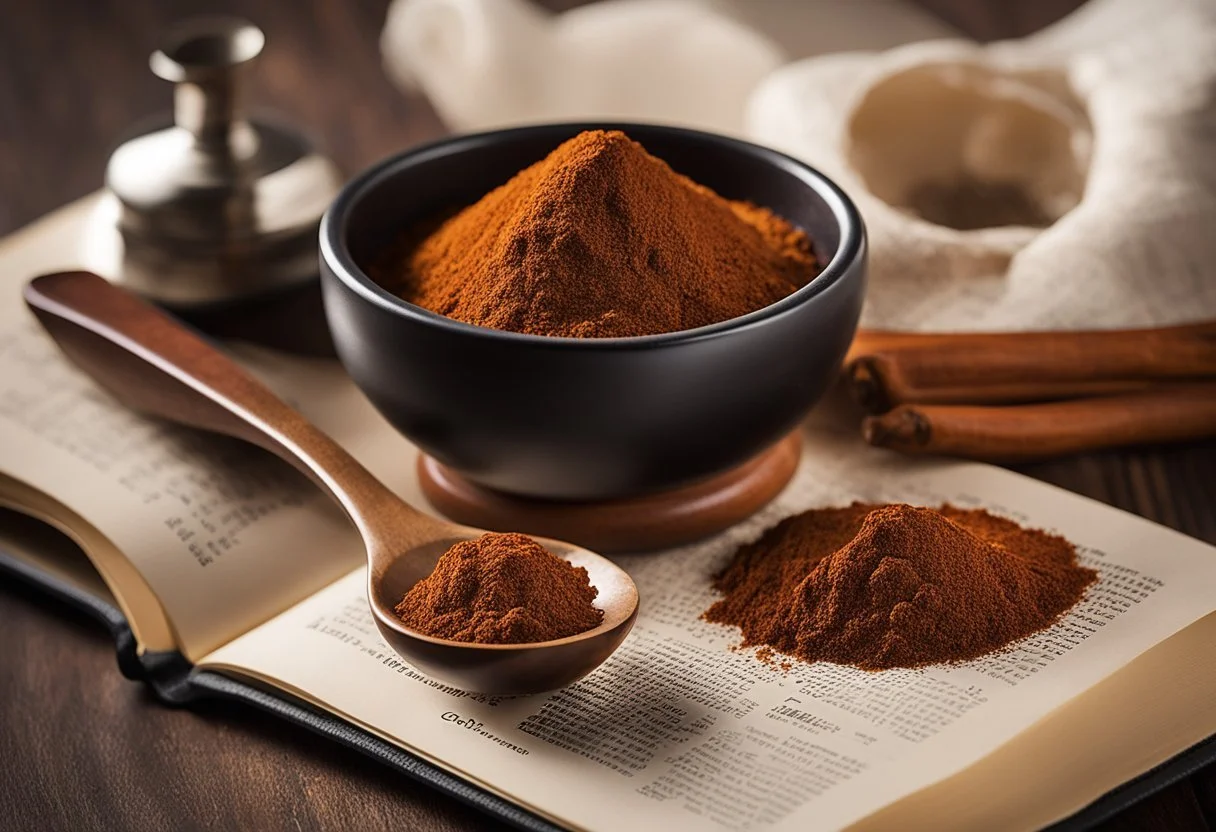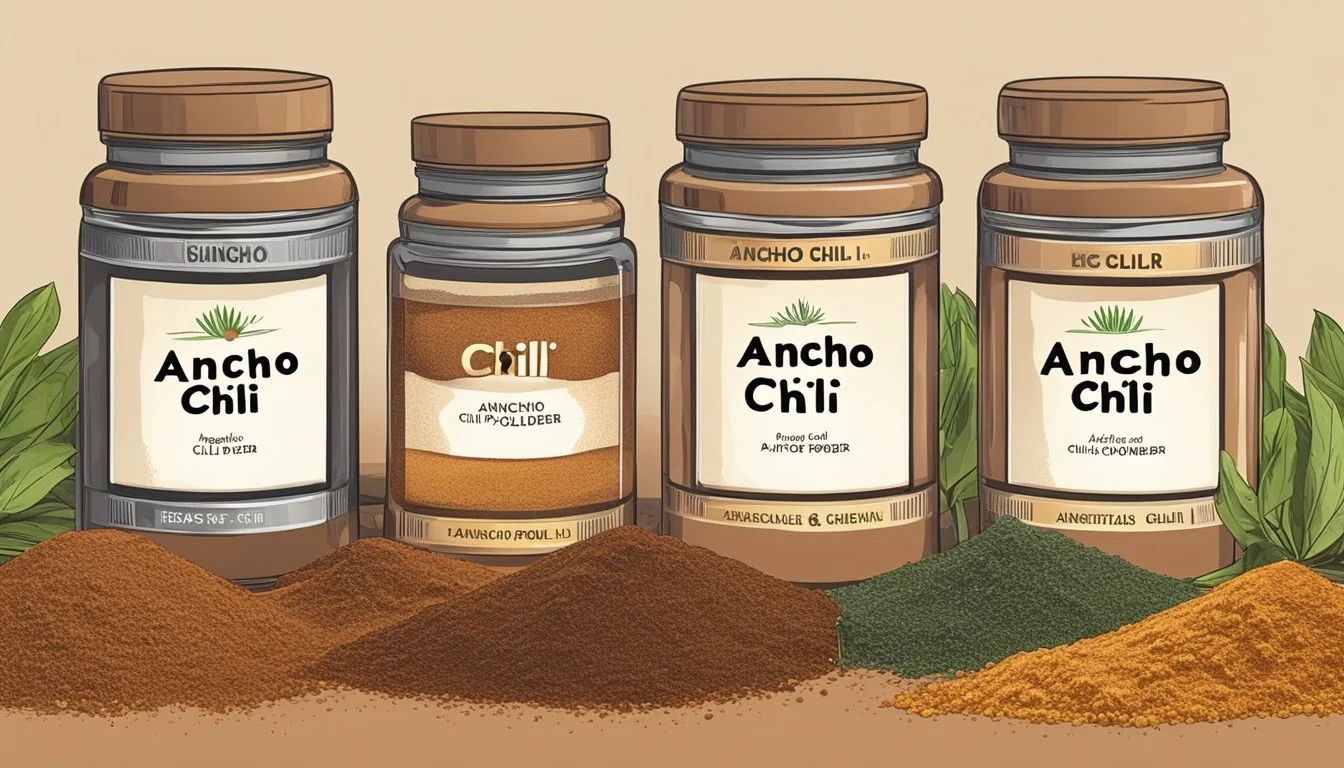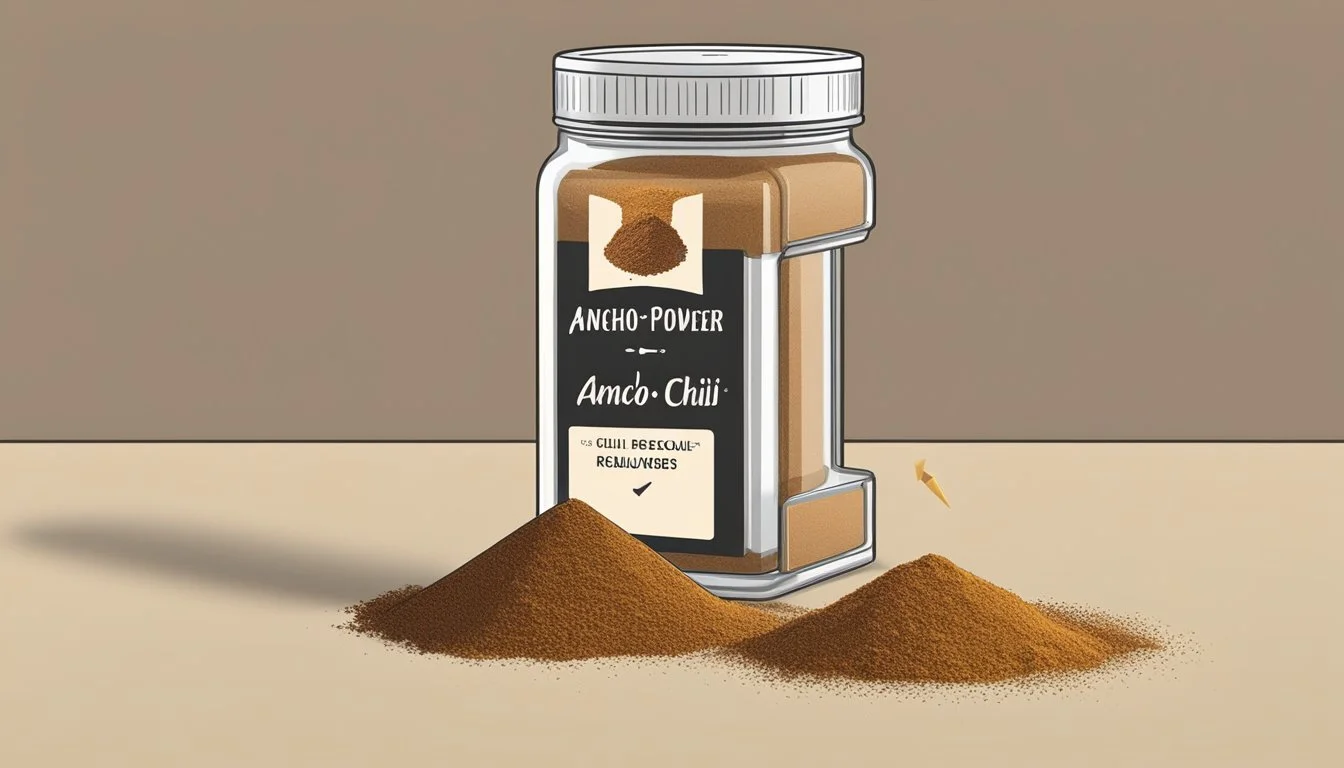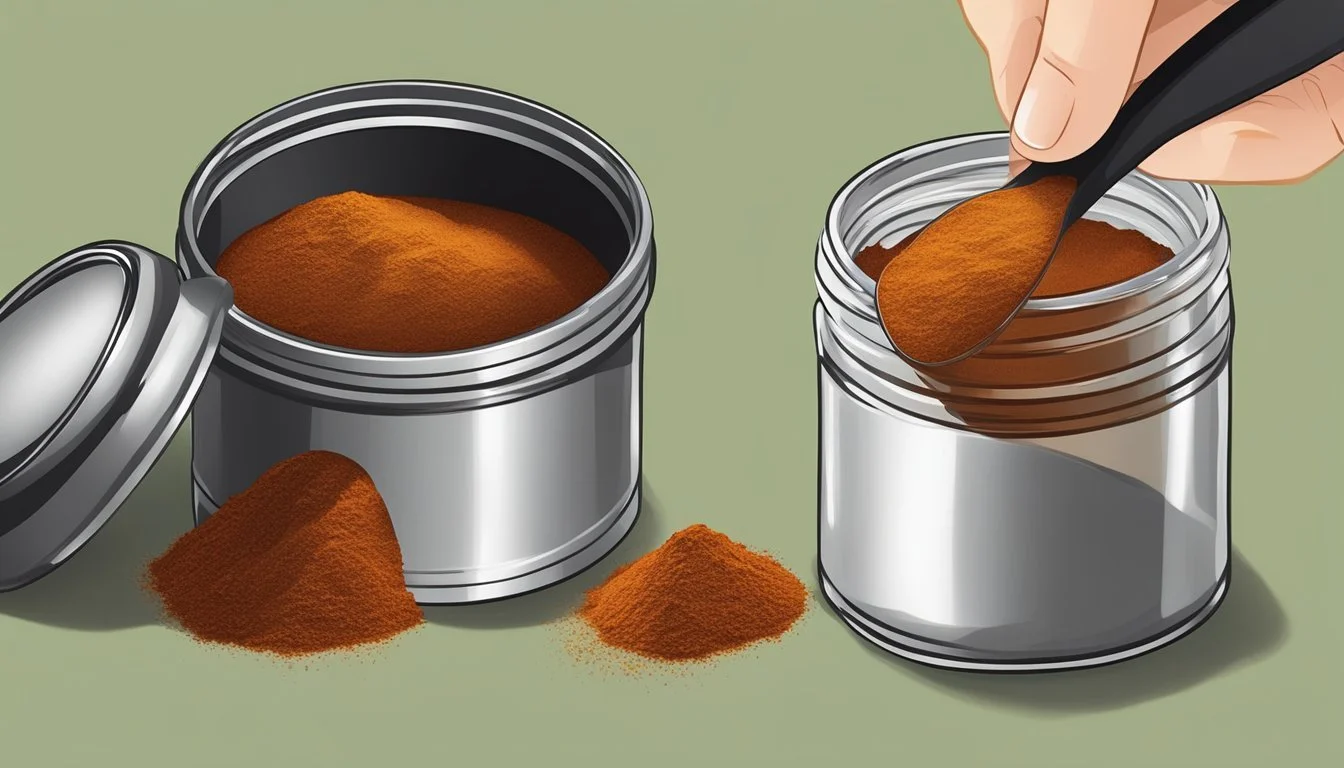How to Substitute Ancho Chili Powder for Regular Chili Powder
A Flavorful Swap Guide
Ancho chili powder is a distinctive spice known for its mild heat and sweet, smoky flavor, derived from dried and ground poblano peppers. Regular
Understanding Chili Powders
Chili powders are essential ingredients in numerous recipes, providing heat and depth to dishes. This section delves into specific types of chili powders, their unique characteristics, and how they compare in terms of flavor and spiciness.
Distinct Characteristics of Ancho Chili Powder
Ancho chili powder is made from dried and ground poblano peppers. They are known for their mild heat level, usually ranging from 1,000 to 1,500 Scoville Heat Units (SHU). Its flavor profile is complex, offering an earthy taste coupled with a smoky sweetness, making it a versatile addition to many culinary preparations.
Profile of Regular Chili Powder
Regular chili powder, on the other hand, is a blend of various spices including ground chili peppers and other seasonings such as garlic powder, oregano, and cumin. It does not come from a single type of pepper. The heat level can vary based on the mix, but it typically has a more pronounced spice component when compared to ancho. Its flavor is richer and less specific due to the range of spices involved.
Comparing Heat Levels and Flavor Profiles
When comparing ancho chili powder to regular chili powder:
Aspect Ancho Chili Powder Regular Chili Powder Heat Level Mild (1,000-1,500 SHU) Varies Flavor Profile Earthy, smoky sweetness Spicy, complex
Ancho chili powder offers a noticeably milder heat and a distinctive smoky flavor not usually found in regular chili powder. In contrast, regular chili powder can contribute a spicier kick to dishes, which may be too intense for those looking for the subtlety of ancho. The key difference lies in the specificity of flavor: ancho provides a singular, nuanced taste, while regular chili powder brings a varied spice palate to the table.
Selecting the Right Substitute
When seeking an alternative to ancho chili powder, it is essential to consider the desired flavor profile and heat level. The correct substitute will bring a comparable depth and complexity to dishes, reflecting the ancho chili's mildly spicy and sweet characteristics.
When to Use Ancho Chili Powder Substitute
Ancho chili powder is often utilized in Mexican cuisine for its mild heat and sweet, smoky flavor. It is suitable in sauces, stews, and meat marinades. One should consider a substitute in situations where ancho chili powder is unavailable or when a slightly different flavor is desired. Substitutes should deliver a similar heat level and complement other spices in the recipe.
Alternative Chili Powder Options
For Ample Heat:
Cayenne Pepper: A potent heat source that should be used sparingly.
Chipotle Powder: Provides a smoky flavor; it's spicier than ancho powder.
For a Milder Taste:
Paprika (Sweet or Smoked): Less intense and offers a sweet or smoky taste respectively.
Guajillo Powder: Similar to ancho but with a tangier, crisper flavor.
For Complex Profiles:
New Mexico Chili Powder: A good balance of sweetness with a mellow heat.
Pasilla Chili Powder: Darker and fruitier, it's less spicy than ancho powder.
Substitute Ratios Table
Substitute Ratio to Ancho Powder Cayenne Pepper Start with 1/4 of the amount, adjust to taste Chipotle Powder 1:1 ratio, adjust for smokiness Paprika 1:1 ratio, but may require more for heat Guajillo Powder 1:1 ratio, adjust for tanginess New Mexico Chili Powder 1:1 ratio, taste and adjust Pasilla Chili Powder 1:1 ratio, adjust for fruitiness
It's important to remember that each substitute will influence the final dish differently. Adjusting quantities and carefully tasting as one cooks is key to achieving a well-balanced dish.
Substitution Ratios
When a recipe calls for ancho chili powder and it's unavailable, chefs can make use of several effective substitutes. The key to a successful substitute lies in matching the heat level and flavor profile as closely as possible. Ancho chili powder is known for its mild heat and sweet, fruity undertones, so the chosen alternative should ideally possess similar characteristics.
Guajillo Chili Powder: A close relative with a comparable mild heat, it can be used in a one-to-one ratio, making it an ideal substitute.
Ancho Chili Powder: 1 teaspoon
Guajillo Chili Powder: 1 teaspoon
Chipotle Powder: With a smokier taste and a spicier kick, chefs should adjust the amount slightly if a less intense heat is desired.
Ancho Chili Powder: 1 teaspoon
Chipotle Powder: ¾ teaspoon
Smoked Paprika: Although less spicy, it brings a smoky flavor. It can often be used measure for measure, but one might consider blending it with a pinch of cayenne to mimic the subtle warmth of ancho chili powder.
Ancho Chili Powder: 1 tablespoon
Smoked Paprika (with a pinch of Cayenne): 1 tablespoon
When adjusting the recipe, remember to consider the overall flavor balance along with the heat level. Ingredients should be complementary, ensuring that the substitute harmoniously integrates into the dish being prepared. This guidance allows for confident, informed adjustments that maintain the integrity of the intended taste and spiciness of the original recipe.
Incorporating Substitutes in Recipes
When substituting ancho chili powder in recipes, the goal is to match the dish's desired flavor profile and heat level without compromising the overall taste. The choice of substitute can vary depending on the recipe and the other ingredients involved.
Adapting to Different Dishes
Different dishes can tolerate the substitution of chili powders differently. For example, enchiladas and tacos that typically rely on the mild heat and sweet, fruity notes of ancho chili might benefit from a mix of smoked paprika and a pinch of cayenne. Meanwhile, soups and stews with a complex range of spices may better accommodate the substitution of guajillo chili powder, which has a comparable but slightly hotter flavor profile.
Marinades: A substitute like chipotle powder can introduce a deeper smokiness to meat marinades, suitable for pork or chicken.
Salsas: To maintain brightness in salsas, a blend of mild chili powders with a touch of cayenne can mimic ancho's heat without overshadowing the other fresh ingredients.
Creating Balanced Flavors
Balancing flavors is essential when incorporating substitutes, as it impacts the dish’s overall taste. Use substitutes that complement the main ingredients:
Pork: For dishes featuring pork, use substitutes like guajillo powder to offer a similar richness without causing a significant shift in the flavor profile.
Chicken: With chicken, a more moderate spice like paprika can be suitable, mirroring ancho's mildness and allowing the chicken's natural flavors to shine through.
Vegetables: Delicate vegetables can be overwhelmed by too much heat, so it's advisable to start with less substitute and adjust as the recipe develops.
Dish Type Suggested Substitute Notes Enchiladas/Tacos Smoked paprika + cayenne Balances sweetness and mild heat. Soups/Stews Guajillo chili powder Provides a deeper flavor. Marinades Chipotle powder Adds smoky notes to meats. Salsas Blend of mild chili powders Maintains fresh flavor profile.
Incorporating these substitutes should be done to taste, considering the impact each alternative might have on the final presentation of the dish.
Making Your Own Ancho Chili Powder
To create homemade ancho chili powder, a cook starts with dried poblano peppers—a staple sold in many grocery stores and recognizable to those familiar with a well-stocked spice rack. These peppers should be deep red to brown in color, indicating appropriate dryness.
Ingredients:
Dried poblano peppers
Instructions:
Before grinding, one must remove the seeds from the peppers to avoid bitterness. Carefully cut or tear open the peppers and shake out the seeds or use a spoon to scrape them away.
Once the seeds are removed, one should also discard the stems.
Now, tear the peppers into smaller, more manageable pieces. These smaller pieces will grind more efficiently.
Place the pieces in batches into a spice grinder or food processor. Pulse until a fine powder forms.
After achieving the right consistency, it is vital to store the powder correctly to maintain its smokiness and flavor profile. Transfer the powder to a jar with a tight-fitting lid and label it clearly as "Ancho Chili Powder".
Store this spice in a cool, dry place, such as a pantry or cupboard, away from direct sunlight.
By preparing ancho chili powder at home, one ensures freshness and robustness of flavor which can elevate any dish requiring a hint of gentle smokiness characteristic of poblano peppers.
Understanding the Impact on Health
When substituting Ancho chili powder for regular chili powder, one can expect certain health benefits characteristic of the mild Ancho chili. Anchos are a type of dried Poblano pepper, carrying vitamins such as Vitamin A, which is crucial for eye health, and Vitamin C, known for its antioxidant properties and support to the immune system.
Capsaicin is the component in chili peppers that contributes to their spiciness and is linked to various health benefits. It is less concentrated in mild peppers like Ancho, making them a gentler option for digestion while still providing benefits such as improved metabolism.
Moreover, Ancho chili powder contains antioxidants, compounds that combat oxidative stress in the body. These substances can contribute to reducing inflammation and protecting against chronic diseases.
Ingredient Health Benefit Vitamin A Supports eye health Vitamin C Boosts immune system Antioxidants Fights oxidative stress Capsaicin (mild) Aids digestion, boosts metabolism
The ingredients within Ancho chili powder provide a unique blend of flavors without overpowering heat, making it a suitable ingredient for those preferring milder spice levels. Using Ancho chili powder in place of regular chili powder can offer a subtle variation in heat, while still infusing dishes with the rich, customary chili flavor, along with the noted health benefits.







